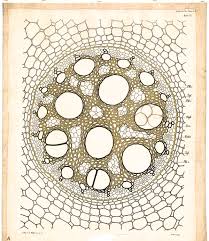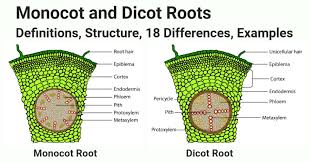ANATOMY OF FLOWERING PLANTS NEET PREVIOUS YEAR QUESTIONS
1.The transverse section of a plant shows following anatomical features:-[NEET 2020]
(a) Large number of scattered vascular bundles surrounded by bundle sheath.
(b) Large conspicuous parenchymatous ground tissue
(c) Vascular bundles conjoint and closed
(d) Phloem parenchyma absent
Identify the category of plant and its part:-
(3) Dicotyledonous root
(4) Monocotylrdonous stem
2. Select the correct pair [NEET 2021]
(1) Loose parenchyma cells rupturing the epidermis- Spongy parenchyma
and forming a lens shaped opening in bark
(2) Large colorless empty cells in the epidermis- Subsidiary cells
of grass leaves
(3) In dicot leaves, vascular bundles are- Conjunctive tissue
surrounded by large thick-walled cells
(4) Cells of medullary rays that form part- Interfascicular cambium
of cambial ring.
3. Which of the following is an incorrect statement? [NEET 2021]
(1) Nuclear pores act as passages for proteins and RNA molecules in both directions between nucleus and cytoplasm
(2) Mature sieve tube elements possess a conspicuous nucleus and usual cytoplasmic organelles
(3) Microbodies are present both in plant and animal cells
(4) The antinuclear space forms a barrier between the materials present inside the nucleus and that of the cytoplasm.
4. Identify the incorrect statement. [NEET 2020]
(1) Sapwood is involved in conduction of water and minerals from root to leaf
(2) Sapwood is the innermost secondary xylem and is lighter in colour
(3) Due to deposition of tannins, resins, oils etc. heat wood is dark in colour
(4) Heart wood does not conduct water but gives mechanical support
5. Match List-I with List-II
List-I List-II
(a) lenticcels (I) Phellogen
(b) Cork cambium (ii) Suberin deposition
(c) Secondary cortex (iii) Exchange of gases
(d) Cork (iv) Phellodem
Choose the correct answer from the options given below. [NEET 2021]
(a) (b) (c) (d)
(1) (iv) (ii) (i) (iii)
(2) (iv) (i) (iii) (ii)
(3) (iii) (i) (iv) (ii)
(4) (ii) (iii) (iv) (i)
6. Match List-I with List-II
List-I List-II
(a) Cells with active cells division capacity– Vascular tissues
(b) Tissues having all cells similar in– Meristematic tissue
structure and function
(c) Tissue having different types of cells– Sclereids
(d) Dead cells with highly thickened– Simple tissue
walls and narrow lumen
Select the correct answer from the options given below [NEET 2021]
(a) (b) (c) (d)
(1) (iii) (ii) (iv) (i)
(2) (ii) (iv) (i) (iii)
(3) (iv) (iii) (ii) (i)
(4) (i) (iii) (ii) (iv)
7. Regeneration of damaged growing grass following grazing is largely due to:- [NEET 2019]
(1) Secondary meristem
(2) Lateral meristem
(30 Apical meristem
(4) Intercalary meristem
8. Grass leaves curl inwards during very dry weather .
Select the most appropriate reason from the following [NEET 2019]
(1) Closure of stomata
(2) Flaccidity of bulliform cells
(3) Shrinkage of air spaces in spongy mesophyll
(4) Tyloses in vessels
9. In the dicot root the vascular cambium originates from:- [NEET 2019]
(1) Infrafascicular and interfascicular tissue in a ring
(2) Tissue located below the phloem bundles and a portion of pericycle tissue above protoxylem.
(3) Cortical region
(4) Parenchyma between endodermis and pericycle
10. Large, empty colourless cells of the adaxial epidermis along the veins of grass leaves are [NEET 2020]
(1) Bulliform cells (2) Lenticels
(3) Guard cells (4) Bundle sheath cells
11. Which of the following statements about cork cambium is incorrect? [NEET 2020]
(1) It is a couple of layers thick
(2) It forms secondary cortex on its outerside
(3) It forms a pert of periderm
(4) It is responsible for the formation of lenticels
12. Casparian stips occur in [NEET 2016]
(1) Epidermis (2) Pericycle
(3) Endodermis (4) Cortex
13. Plants having little or no secondary growth are [NEET 2018]
(1) Grasses (2) Deciduous angiosperms
(3) Cycads (4) Conifers
14. Which of the following is made up of dead cells? [NEET 2017]
(1) Xylem parenchyma (2) Colenchyma
(3) Phellem (4) Phloem
15. Which of the statements given below is not true about formation of Annual Rings in trees? [NEET 2019]
(1) Annual ring is a combination of spring wood and autumn wood produced in a year
(2) Differential activity of cambium causes light and dark bands of tissue early and late wood respectively
(3) Activity of cambium depends upon variation in climate.
(4) Annual rings are not prominent in trees of temperature region.
16. Stomata in grass leaf are [NEET 2018]
(1) Dumb-bell shaped (2) Kidney shaped
(3) Barrel shaped (4) Rectangular
17. Identify the wrong statement in context of heartwood [NEET 2017]
(1) Organic compound are deposited in it
(2) It is highly durable
(3) It conducts water and minerals efficiently
(4) It comprises dead elements with highly lignified walls
18. Phloem in gymnosperms lacks:- [NEET 2019]
(1) Albuminous cells and sieve cells
(2) Sieve tubes only
(3) Companion cells only
(4) Both sieve tubes and companion cells.
19. Secondary xylem and phloem in dicot stem are produced by [NEET 2018]
(1) Apical meristems (2) Vascular cambium
(3) Axillary meristems (4) Phellogen
20. A major characteristic of the monocot root is the presence of
(1) Cambium sandwiched between phloem and xylem along the radius.
(2) Open vascular bundles
(3) Scattered vascular bundles
(4) Vasculature without cambium
21. Read the following components from (a) to (d) in the list given below and tell the correct order of the components with reference to their arrangement from outer side to inner side in a woody dicot stem
(a) Secondary cortex (b) Wood
(c) Secondary phloem (d) Phellem
(1) (d), (c), (a), (b) (2) (c), (d), (b), (a)
(3) (a), (b), (d), (c) (4) (d), (a), (c), (b)
22. Cortex is the region found between [NEET 2016]
(1) Epidermis and stele
(2) Pericycle and endodermis
(3) Endodermis and pith
(4) Endodermis and vascular bundle
23. Vascular bundles in monocotyledons are considered closed because
(1) Xylem is surrounded all around by phloem
(2) A bundle sheath surrounds each bundle
(3) Cambium is absent
(4) there are no vessels with perforations.
24. The balloon -shaped structures called tyloses [NEET 2016]
(1) Originate in the lumen of vessels
(2) Characterize the sapwood
(3) Are extensions of xylem parenchyma cells into vessels
(4) Are linked to the ascent of sap through xylem vessels
25. Specialised epidermal cells surrounding the guard cells are called [NEET 2016]
(1) Lenticels (2) Complementary cells
(3) Subsidiary cells (4) Bulliform cells
26. The vascular cambium normally gives rise to [NEET 2017]
(1) Phelloderm (2) Primary phloem
(3) Secondary xylem (4) Periderm
27. Age of tree can be estimated by [NEET 2014]
(1) Biomass (2) Number of annual rings
(3) Diameter of its heartwood (4) Its height and girth
28. Water containing cavities in vascular bundles are found
(1) Cycas (2) Pinue
(3) Sunflower (4) Maize
29. Interfascicular cambium develops from the cells of [NEET 2013]
(1) Xylem parenchyma (2) Endodermis
(3) Pericycle (4) Medullary rays
30. Companion cells are closely associated with
(1) Trichomes (2) Guard cells
(3) Sieve elements (4) Vessel elements
31. The common bottle cork is a product of
(1) Xylem (2) Vascular cambium
(3) Dermatogen (4) Phellogen
32. As compared to a dicot root, a monocot root has
(1) More abundant secondary xylem
(2) Many xylem bundles
(3) Inconspicuous annual rings
(4) Relatively thicker periderm
33. Function of companion cells is
(1) Loading of sucrose into sieve elements by passive transport
(2) Loadingg of sucrose into sieve elements
(3) Providing energy to sieve elements for active transport
(4) Providing water to phloem
34. Ground tissue incudes
(1) All tissues internal to endodermis
(2) All tissues external to endodermis
(3) All tissues except epidermis and vascular bundles
(4) Epidermis and cortex
35. In land plantss, the guard cells differ from other epidermal cells in having
(1) Chloroplasts (2) Cytoskeleton
(3) Mitochondria (4) Endoplasmic reticulum
36. The cork cambium, cork and secondary cortex are collectively called
(1) Phellem (2) Phelloderm
(3) Phellogen (4) Periderm
37. Which one of the following is wrongly matched?
(1) Cassia- Imbricate aestivation
(2) Root pressure- Guttation
(3) Puccinia- Smut
(4) Root- Exarch protoxylem
38. Some vascularbundles are described as open because these.
(1) Possess conjunctive tissue between xylem and phloem
(2) Are not surrounded by pericycle
(3) Are surrounded by pericycle but no endodermis
(4) Are capable of producing secondary xylem and phloem
39. The chief water conducting elements of xylem in gymnosperms are
(1) Tracheids (2) Vessels
(3) Fibers (4) Transfusion tissue
40. Closed vascular bundles lack
(1) Cambium (2) Pith
(3) Ground tissue (4) Conjunctive tissue.
ANSWER
1. (4) 2. (4) 3.(2) 4. (2) 5. (3) 6. (2) 7. (4) 8. (2) 9. (2) 10. (1)
11. (2) 12. (3) 13. (1) 14. (3) 15. (4) 16. (1) 17. (3) 18. (4) 19. (2) 20. (4)
21. (4) 22. (1) 23. (3) 24. (3) 25. (3) 26. (3) 27. (2) 28. (4) 29. (4) 30. (3)
31. (4) 32. (2) 33. (2) 34. (3) 35. (1) 36. (4) 37. (3) 38. (4) 39. (1) 40. (1)
QUOTE:-“THERE ARE NO SHORTCUTS TO ANY PLACE WORTH GOING”

